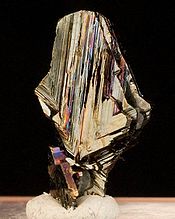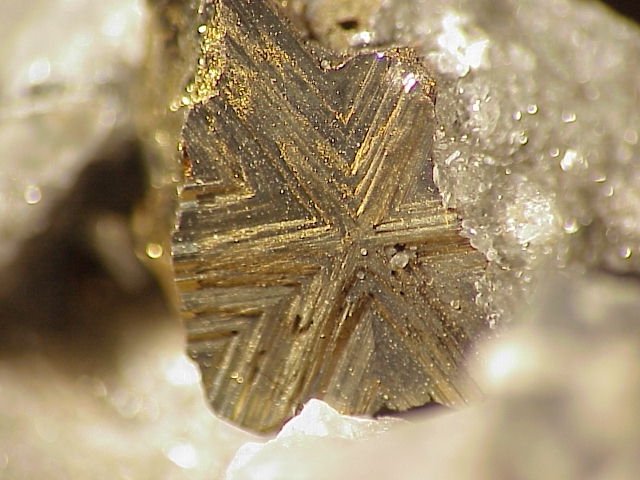Cubanite
Cubanit, also Barracanit or Chalmersit, is a rarely occurring mineral from the mineral class of sulfides and sulfosalts. It crystallizes in the orthorhombic crystal system with the chemical composition CuFe2S3 and forms elongated crystals and thick, striped panels of up to three centimeters in size from brass to bronze -like color. Often sternen or flower-shaped crystal twins found that simulate a hexagonal symmetry.
Special Features
In the structure of the metal ions are present in various oxidation states. The copper is monovalent, and both two-and trivalent iron ions in the lattice exists. These are each present in pairs tetrahedra which are interconnected by means of joint edges. This leads to rapid electron transitions between the iron ions. The mineral is characterized a semiconductor. At the same time Cubanit is strongly magnetically along the c -axis.
Etymology and history
Cubanit was first described in 1843 by August Breithaupt, who examined a mineral sample provided to him more closely. This had brought six barrels of the unknown mineral from Cuba to England to perform melting experiments. Breithaupt named the mineral after the place of origin, the island of Cuba Cubanit.
Classification
In the classification of minerals according to Strunz Cubanit is counted among the metal sulfides with a ratio of metal to sulfur, selenium or tellurium of 1:1. After the 8th edition forms a group together with Argento pyrite, enargite, Sternbergit and Stibioenargit. The 9th edition, it forms with Isocubanit a subset of sulfides of zinc, iron, copper or silver.
In the classification by Dana it forms with Argento pyrite and Isocubanit a subset of the sulfides, selenides and tellurides with the composition AmBn Xp, with (m n): p = 1:1.
Modifications and varieties
Above 210 ° C, changing the crystalline structure of the Cubanites. It forms a cubic modification, the Isocubanit is called and also occurs naturally. To find Isocubanit is usually near black smokers, such as in the Pacific.
Also, two high-pressure modifications are known. At 3.3 GPa pressure, Cubanit converts at room temperature in a hexagonal modification. Whose structure is similar to the Nickelarsenidstruktur. At still higher pressures from 3.4 to 5.8 GPa, the properties of Cubanites vary greatly, it forms a metallic modification.
Education and Locations
Cubanit formed under hydrothermal conditions at elevated temperatures in pyrrhotite - pentlandite ores. It is formed by unmixing of chalcopyrite, with which it is often severely overgrown, at 200-210 ° C. It is associated with chalcopyrite, pyrite, pyrrhotite, pentlandite and sphalerite.
Worldwide Cubanit has been (as of 2009) detected at around 480 localities in which it occurs locally in larger quantities. Among the localities include the type locality Barracanao in Cuba, Sudbury and Chibougamau Canada, Tunaberg and Ljusnarsberg in Sweden, Virtasalm in Finland, Traversella in Italy, Nova Lima, Brazil, Broken Hill in Australia, Norilsk in Russia, and the U.S. states New Mexico, Arizona and Alaska.
Rarely do you find Cubanit in carbonaceous chondrite, a meteorite.
Crystal structure
Cubanit crystallizes in the orthorhombic crystal system, space group Pcmn with the lattice parameters a = 6.458 (1) Å, b = 11.104 (1) Å and c = 6.220 (1) Å and four formula units per unit cell.
Use
Is Cubanit, such as in Ontario in Canada, locally available in large quantities, it is mined as copper ore for the production of elemental copper.










